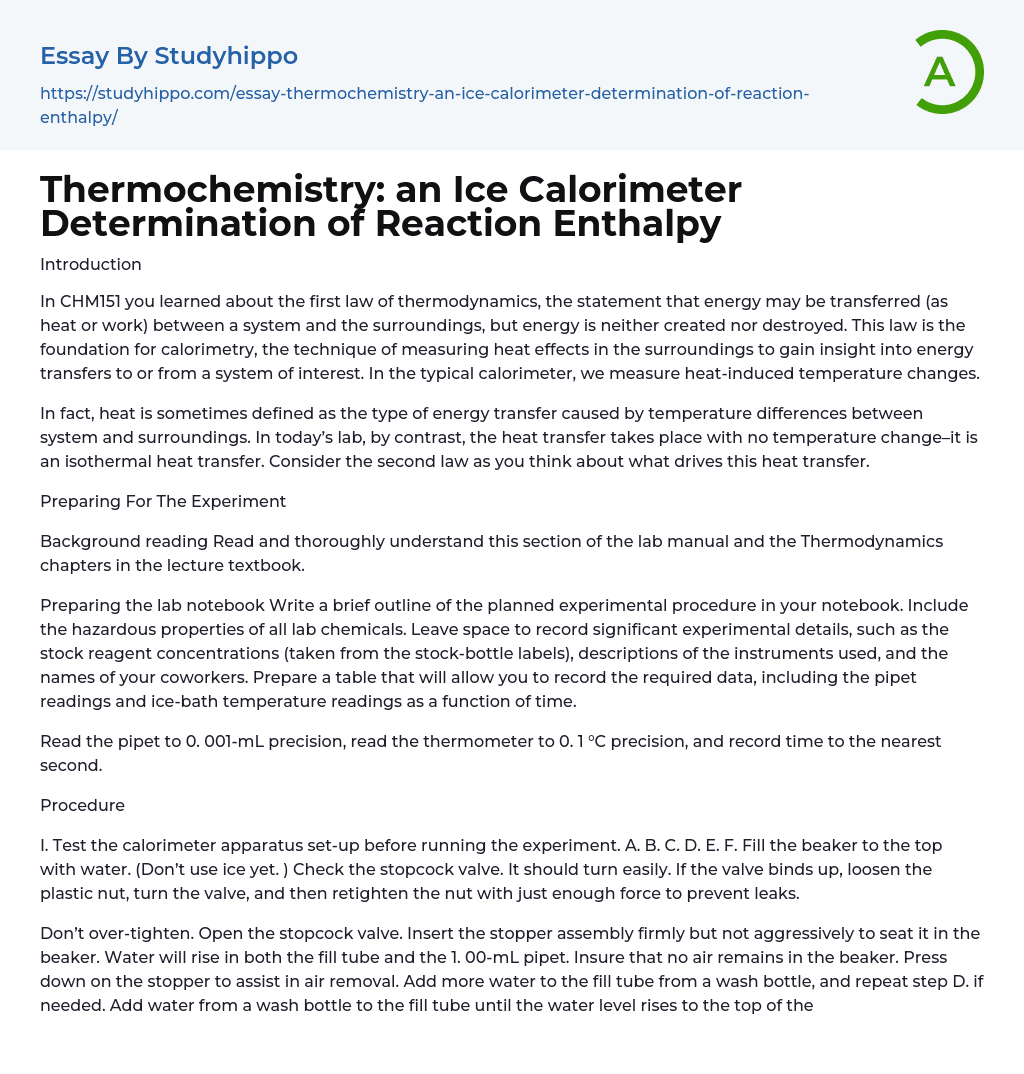

Thermochemistry: an Ice Calorimeter Determination of Reaction Enthalpy Essay Example
Introduction
Introduction
In CHM151, we studied the first law of thermodynamics which states that energy can be transferred (as heat or work) between a system and its surroundings, but it cannot be created or destroyed. Calorimetry is a technique used to measure heat effects in the surroundings in order to understand energy transfers to or from a system. In traditional calorimeters, temperature changes are used as indicators of heat transfer. Heat itself is defined as the type of energy transfer that occurs due to temperature differences between the system and surroundings. However, in today's lab, an isothermal heat transfer takes place without any change in temperature. It is important to consider this type of heat transfer in relation to the second law of thermodynamics.
Preparing For The Experiment
To begin, carefully read and comprehend this section of the lab manual as well as the Thermodynamics chapters in the
...lecture textbook.
Afterwards, outline the intended experimental procedure in your lab notebook. Ensure that you include information regarding the hazardous properties of all laboratory chemicals. Also, ensure that there is enough space in your notebook to document important experimental details such as concentrations of stock reagents (from labels on stock bottles), descriptions of instruments used, and names of colleagues involved.
In addition, establish a table for recording necessary data. This should encompass pipet readings and ice-bath temperature readings at various time points. Finally, remember to set the pipet reading to 0 before initiating the experiment.
The thermometer should be read with a precision of 0.1°C, the time must be recorded to the nearest second, and the volume measurement needs to be accurate to 0.01 mL.
Procedure
I. Before conducting the experiment, ensure that the calorimeter apparatu
is thoroughly tested.
Fill the beaker with water, making sure it is filled to capacity and do not add ice at this time.
Check the stopcock valve to ensure it turns smoothly. If it becomes hard to turn, loosen the plastic nut, turn the valve, and then tighten the nut enough to prevent any leaks. Be careful not to overtighten. Open the stopcock valve and firmly place the stopper assembly into the beaker without using excessive force to position it correctly.
Water will rise in both the fill tube and the 1.00-mL pipet, ensuring that no air remains in the beaker. You can press down on the stopper to assist in air removal. Additionally, add more water to the fill tube from a wash bottle and repeat step D.
Using a wash bottle, add water to the fill tube until the water level reaches the top.
- Organic Chemistry essays
- Acid essays
- Calcium essays
- Chemical Bond essays
- Chemical Reaction essays
- Chromatography essays
- Ethanol essays
- Hydrogen essays
- Periodic Table essays
- Titration essays
- Chemical reactions essays
- Osmosis essays
- Carbohydrate essays
- Carbon essays
- Ph essays
- Diffusion essays
- Copper essays
- Salt essays
- Concentration essays
- Sodium essays
- Distillation essays
- Amylase essays
- Magnesium essays
- Acid Rain essays
- Melting essays
- Agriculture essays
- Albert einstein essays
- Animals essays
- Archaeology essays
- Bear essays
- Biology essays
- Birds essays
- Butterfly essays
- Cat essays
- Charles Darwin essays
- Chemistry essays
- Dinosaur essays
- Discovery essays
- Dolphin essays
- Elephant essays
- Eli Whitney essays
- Environmental Science essays
- Evolution essays
- Fish essays
- Genetics essays
- Horse essays
- Human Evolution essays
- Isaac Newton essays
- Journal essays
- Linguistics essays



